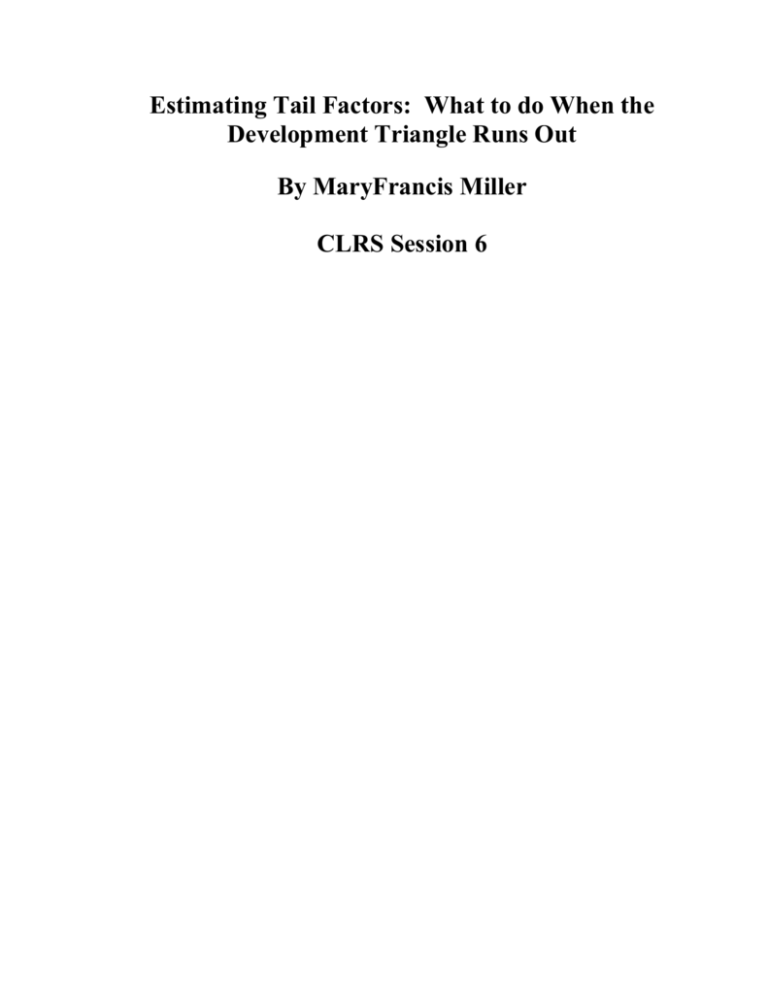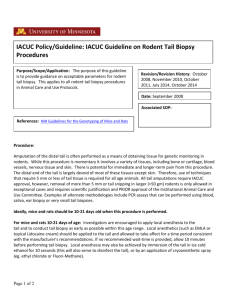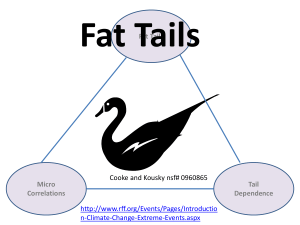the Modified Bondy Method
advertisement

Estimating Tail Factors: What to do When the
Development Triangle Runs Out
By MaryFrancis Miller
CLRS Session 6
Estimating Tail Factors – Current Methods
Tail Factors
o
Used for development beyond the oldest maturity in
the triangle
o
Challenging to estimate because, by definition, they
are not estimable using the triangle itself
o
For example, U.S. workers compensation claims may
take 30 years or more to pay out, but the data in
Schedule P only shows 10 years of history
o
In this segment of the session, will survey the most
popular methods in broad use today for computing tail
factors
Page 2
Estimating Tail Factors – Current Methods
List of Four Broad Approaches That are Used
o
Bondy-Type ‘Repeat the Last Link Ratio’ Methods
o
Methods Based on Algebraic Relationships Within the
Paid and Incurred Loss Triangle
o
Curve-Fitting Methods
o
Use of Benchmarks
Page 3
Estimating Tail Factors – Current Methods
First, the Bondy Methods
o
Why are the Bondy Methods First?
o
They are the Simplest
o
Variations on a Theme of ‘Repeat the Last Link
Ratio’
Page 4
Estimating Tail Factors – Current Methods
First Bondy Approach - the Bondy Method
o
Just repeat the last link ratio for the tail factor
o
Developed at ISO in an era of less extended
development (1960’s-70’s)
At least less perceived development
o
Does seem to usually generate a lower tail factor than
most other methods
o
Is ‘approximately equal’ to the use of the exponential
decay method (discussed later), with a decay between
tail factors of 50%
Page 5
Estimating Tail Factors – Current Methods
the Modified Bondy Method
o
Instead of just repeating the last link ratio, double the
‘development portion’ of the last link ratio
o
If the last link ratio is 1+d, use 1+2d
o
Equvalent to ‘exponential decay’ approach, with
decay factor of 2/3
Page 6
Estimating Tail Factors – Current Methods
Methods Based on Algebraic Relationships Within
the Paid and Incurred Loss Triangle
o
o
These methods involve computing
o some single quantity that
o describes a simple relationship
o between paid and incurred loss
o that generates a tail factor
o does
not involve complex
assumptions
mathematical
This category is designed to exclude curve fitting as
curve fitting usually involves multiple quantities and
inevitably
involves
complex
mathematical
assumptions.
Page 7
Estimating Tail Factors – Current Methods
First Algebraic Method - Equalizing the Paid and
Incurred Estimates of Ultimate Losses
- Fundamentals –
o
Used when one of the estimates already has a tail
factor available
Incurred may show negligible development near tail
McClenahan’s method (discussed later) may be used
for paid tail factor
o
Set either
Paid loss tail factor = (ultimate loss for oldest year
in
triangle
determined
by
incurred
development)(paid loss to-date for oldest year in
triangle); or
Incurred loss tail factor = (ultimate loss for oldest
year in triangle determined by paid loss
development)(incurred loss to-date for oldest year
in triangle)
Page 8
Estimating Tail Factors – Current Methods
Equalizing the Paid and Incurred Estimates of
Ultimate Losses
- Pros and Cons o
Underlying theory – the ultimate losses that both tests
are estimating is one number, so both tests should
produce the same number
That is both a simple assumption and a very likely
assumption, so this is a very good method to use
when you can
o
Disadvantage – You have to already know one tail
factor to use this
Page 9
Estimating Tail Factors – Current Methods
Second Algebraic Method –Ratio of Paid Loss to
Reserves Disposed of
o
Will be part of second half of session
o
This is actually a new method
Page 10
Estimating Tail Factors – Current Methods
The Curve Fitting Methods
o
These methods generally involve fitting a curve to
either paid loss or (paid or incurred) link ratios
o
As such, they inevitably involve some sort of
assumption about the decay of development that is
used to project development
o
The assumption gives rise to a family of curves, and
the member of that curve family that best fits the data
is found either by a ‘least squares’ linear fit of some
sort, or complex numerical analysis
o
Fits that can be done using spreadsheet line-fitting
functions and a little spreadsheet algebra are
preferred due to ease of use.
Page 11
Estimating Tail Factors – Current Methods
First Curve Fit – McClenahan’s Method
-Fundamentals –
o
Basic Theory
First, there is a lag until any payments are made
due to delay in reporting claims.
Then, once payments begin, the amount of
payments for each accident month of claims must
decrease eventually.
Assume the decrease is proportional to the last
amount paid.
Just as that converts to exponents of 1+i in interest
theory, this converts the payout pattern by month of
each accident month to exponents of 1-q=p.
Page 12
Estimating Tail Factors – Current Methods
McClenahan’s Method
Notes
o
McClenahan fits a separate curve to each accident
year
o
For Tail Factor purposes using a set of link ratios
instead of each accident year’s payments
First set $100 as paid in first twelve months of
development
Multiply by successive link ratios to get ‘cumulative
paid’ at later development stages.
Subtract ‘cumulative paids’ from adjacent
development stages to get ‘incremental paids’
equivalent to the $100 of beginning paid
After fitting curve, tail factor is function of delay
constant and rate of decrease in fitted curve
Page 13
Estimating Tail Factors – Current Methods
McClenahan’s Method – Detailed Calculations
o
Basically, fitting of exponential decay curve to paid
loss
McClenahan fits curves to the month-by month
development of each accident month
He adds a delay factor (I’ll call it ‘a’ to avoid
confusion with the ‘d’ in development factors
denoted ‘1+d’) for the number of months until the
first payment is made
His curve, for each accident month, reduces to
Ap(m-a)q,
where p is the decay rate on a month-by-month
basis, q = 1-p, and A is the ultimate cost of the
accident month
o
Of course, data is on an annual, not monthly, basis, so
I use
r = p12
to simplify the calculations
o
The implied (fitted) tail factor is then
12q/{12q - pm-a--10 (1- p12) }, m=#months tail factor is
to be applied to
Page 14
Estimating Tail Factors – Current Methods
McClenahan’s Method
- Pros and Cons -
o
o
The curve assumption is a fairly simple one
That is both a pro (it’s not complex) and a con (it may
not fit the data)
o
It is still a heavily theoretical assumption
o
Fitting the curve can present problems
Once ‘a’ is introduced, the curve fit becomes
difficult and some degree of numerical analysis
must be used, rather than built-in spreadsheet
functions.
McClenahan suggests just using average report lag
for ‘a’.
Page 15
Estimating Tail Factors – Current Methods
Skurnick’s Simplification of McClenahan’s
Method
-Fundamentals –
o
o
Skurnick simplifies McClenahan’s
removing the delay constant ‘a’
method
by
Then the tail factor reduces to
(1-r)(1-r-ry)
Where r = p12 is the annual decay factor, and y =
12m is the maturity in years that the tail factor will
apply to.
Page 16
Estimating Tail Factors – Current Methods
Skurnick’s Method
- Pros and Cons o
o
Fitting the curve is easier, and can be done by
Taking the natural logarithms of the payments (or
$100 at 12 month payment pattern)
Fitting a line to them using spreadsheet functions.
Disadvantage is that most payout curves start with low
payouts, increase to a ‘hump’, and then decrease, but
this function is automatically monotone decreasing
with no ‘hump’ possible,
So the fit may not be as good.
Attempt to make the curve fit data that it doesn’t fit
often produces unreliable results
Page 17
Estimating Tail Factors – Current Methods
Exponential Decay of Link Ratios
-Fundamentals –
o
o
o
o
Still fitting exponential curve
But fitting it to the ‘development portion’ of link
ratios
If an individual link ratio is 1+d, ‘d’ is the
‘development portion’ of the link ratio.
Basic assumption is very similar to that of
McClenahan/Skurnick – decay is proportional to the
size of the most recent ‘development portion’.
Leads to exponential decay of the ‘d’s with decay
running across development stages.
Page 18
Estimating Tail Factors – Current Methods
Exponential Decay of Link Ratios
- Calculations –
o
Get the development portion ‘dy’ of the link ratio for
each maturity y in years as
Link ratio for ‘y’ years of initial maturity with unity
(1.0) subtracted out
o
Take the natural logarithmns of the dys
o
Fit a line to those and get slope and intercept of line
o
o
o
Exponent of the line’s slope is the annual decay rate
‘r’ of the link ratios
Exponent of the intercept is the ‘zero years’
development portion ‘D’
Tail factor estimate is
1+ D ry+1/(1-r).
Page 19
Estimating Tail Factors – Current Methods
Exponential Decay of Link Ratios
- Pros and Cons o
Based on a simple assumption
As with McClenahan’s method, that is both a
strength in it’s simplicity and weakness if it does not
fit the data.
o
Fairly easy to compute using spreadsheet functions.
Page 20
Estimating Tail Factors – Current Methods
Sherman’s Method – The Inverse Power Curve
-Fundamentals –
o
Rationale for use is practical, not theoretical
In a test, the inverse power curve fit the data better
than other common curve families
o
Like the exponential decay of link ratios, this involves
fitting a curve to the development portions ‘dy’ of the
link ratios from maturity 1, 2, 3…y,y+1,… in years
o
The curve is of the form ayb, so the fitted link ratios
look like 1+ ayb
o
The challenge is to estimate the ‘a’ and ‘b’ in the
formula
Note that ‘a’ is not a delay factor in this case
Page 21
Estimating Tail Factors – Current Methods
Sherman’s Method – The Inverse Power Curve
- Calculations –
o
First, take natural logarithm of development portions,
the ‘dy’s, of the link ratios
o
Then take the logarithms of the development stages in
years (alternately, months of maturity are used in
paper)
o
Then fit a line with the logs of the development stages
as the independent variable, and the logs of the
development portions as the dependent variable.
The slope of the line (unexponentiated) is the
estimate of ‘b’
The exponent of the intercept is the ‘a’ in the fitted
power curve
o
The estimated link ratios are 1+ ayb, for all years of
maturity ‘y’
o
Multiply all link ratios for years beyond the triangle
together, at least as long as the links have enough of a
development portion to impact the calculation –
The result is the tail factor estimate.
Page 22
Estimating Tail Factors – Current Methods
Sherman’s Method – The Inverse Power Curve
- Pros and Cons –
o
Better fit per testing by Sherman
o
Reasonably easy to calculate
o
No explicit formula for tail factor, must simply
calculate future links
o
Rationale a little difficult to explain – ‘It works
because tests show it works’
Page 23
Estimating Tail Factors – Current Methods
Curve Fitting
Other Types of Curves & Reasons Why They are
Not Often Used
o
Logarithmic – fit 1-a+bln(y) to the cumulative
payments pattern
Does not converge - Can get as high a tail factor as
want by taking successive fitted links
o
Lognormal – fit to cumulative payments pattern
Requires numerical analysis to fit
o
Weibull – fit to cumulative payments pattern
Requires numerical analysis to fit
Page 24
Estimating Tail Factors – Current Methods
Curve Fitting
Other Important Aspects
o
McClenahan, Skurnick, & Exponential Decay are all
‘Asymptotically Equal’
They tend to produce more and more similar results
at larger stages of development
This is because all use the exponential decay
assumption in one way or another
o
Sherman’s inverse power curve is by nature slower to
decay, so it is ‘Asymptotically higher’ than the other
three methods
As evidence, it usually indicates higher tail factors
than the other methods
o
Sometimes the curves just do not fit the data
Look for a cycle of the fit errors. If they are all
positive at first, then all progressively negative,
possibly even positive again at the last, or this
occurs with the signs reversed, the curve has poor
fit.
Page 25
Estimating Tail Factors – Current Methods
Use of Benchmark Data
o
When a good benchmark tail factor is available, this is
both one of the easiest and yet most useful methods
o
Simply take the LDF to ultimate at y years of maturity
from the benchmark for the tail factor at y years of
maturity
Page 26
Estimating Tail Factors – Current Methods
Use of Benchmark Data
What Makes A Good Benchmark Tail
o
Reliable development data is available for older
maturities than are ‘reliably available’ in the data you
are trying to develop
o
The issues that drive development in the benchmark
are similar to the issues that drive development in the
data you are trying to develop
o
The intensity of the issues in the benchmark is similar
compared to the data you are trying to develop
o
Examples of issues
o
Case reserve inadequacy/case reserving practices
Settlement rates
Presence of larger, more difficult claims
Potential for reporting delays
Delays in discovery of loss
Delays in reporting due to attorney involvement
And more
One method of checking-does the development at
earlier maturities look similar?
Page 27
Estimating Tail Factors – Current Methods
Summary
o
Reviewed several methods of developing tail factors
o
Advised on pros and cons of each
o
Hope it is helpful to attendees
Page 28







